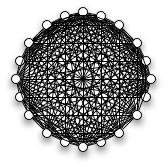I currently work in a relatively large development team. As is the case with every team of that size, we are organized as one enormous group where everybody works with everybody else, every day. I've graphed out our team interactions. I'm sure it looks a lot like your team, right?

 Wait: does that sound weird, based on your experience? You're right, I made it all up. We're not organized as one enormous group, we're grouped into smaller teams like everybody else. Yet to a degree, the larger group has to be able to coordinate between every single person, every day. How is this accomplished?
Wait: does that sound weird, based on your experience? You're right, I made it all up. We're not organized as one enormous group, we're grouped into smaller teams like everybody else. Yet to a degree, the larger group has to be able to coordinate between every single person, every day. How is this accomplished?
Even in a relatively small group of people, a certain pattern emerges. Most individuals in the group interact with a small number of others, but a few are far more highly connected and routinely interact with dramatically more. These connectors result in enormous groups, loosely coupled. This is the phenomena which leads to the six degrees of separation theory, that on average any two people on the planet can be connected by six friends of friends. This pattern is also the basis of the six degrees of Kevin Bacon, who is one of those "highly connected" nodes in the graph of film actors.
The Small World Pattern
This phenomena is called the Small World pattern. I first read about it in Here Comes Everybody.

Here Comes Everybody, chapter 9.
... the chance that you know [a highly connected person] is high. And the "knowing someone in common" link - the thing that makes you exclaim "Small World!" with your seat mate - is specifically about that kind of connection.
The Small World Pattern seems obvious, in hindsight. Of course some people are simply more social and outgoing that others. They make an effort to meet people. They form connections. They are far more connected to other people than most.
The rest of this musing will concern the Small World Pattern in engineering organizations.
The Small World Scoffs at Your Orgchart
Connections can be forced, organizationally: a regular meeting between tech leads from related projects, for example. Connections can also happen by happenstance, as when members of different teams work at adjacent desks. However, the strongest connections happen because some percentage of the engineering population wants to be connected. They are outgoing, and enjoy talking to people outside their immediate coworkers. These connections are far more persistent, and likely to survive past the end of any particular project or recurring meeting.
No Group is an Island, but Some are Peninsulas
Something which can happen in a large company: you work on an infrastructure project which should be applicable in a number of different areas, yet never seems to get the attention you think it deserves. Other groups which could leverage your work instead do their own thing, and later only grudgingly evaluate your system before pronouncing it unfit. Is it because you've misunderstood their requirements? Is it because they think your implementation is poor?
More likely, its because you lack connections from your group to others. It takes just one person in the right place at the right time to say "we should go talk to John on Project Foo." When these suggestions are made organically and at the right time, they are far more likely to be acted upon. When such a suggestion comes as an edict way after the decision point, such as via some recurring meeting, it is far less likely to be received favorably.
To the Connector Go the Spoils
Being highly connected within an engineering organization reaps many rewards. People associate them with the good outcomes of serendipitous introductions.
Being highly connected within an engineering organization also suffers some downsides. I wish I understood the psychological reason why, but nonetheless it happens: Technical competence as an individual contributor will be questioned more often if you spend significant time interacting with other groups. Its weird.
Closing Thoughts
Engineers are human, though in your daily work it might not always seem so. Understanding human behavior is as important in our field as in any other. I highly recommend Shirky's Here Comes Everybody, and his subsequent Cognitive Surplus. Both are excellent.